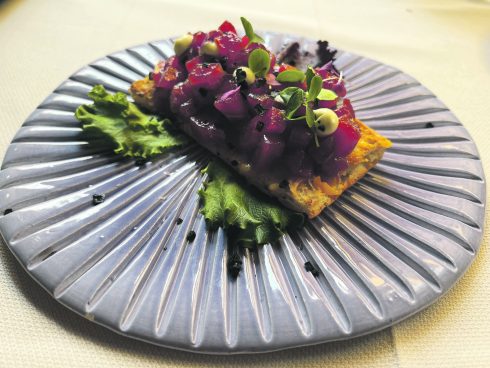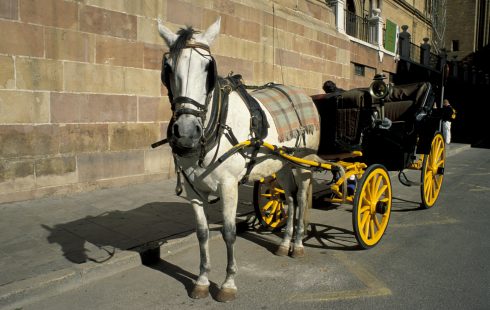IT was in 1910 that the loin in lard roll first graced the tables at roadside Venta Pinto (www.ventapinto.com).
Served warm, normally with a snifter of sherry, it literally oozed with the feel-good factor, if not exactly a road to good health.
As delicious today as it was then, thankfully, the menu at this family-owned restaurant, on the main road from Vejer to Barbate, is as light or rich as you want it to be, with plenty of salads and gallons of seafood to boot.

As is the norm for restaurants on this wonderful stretch of Cadiz coastline, you must try the tuna.
The morillo cut is one of the best, but if it’s on offer definitely go for the creative tuna ‘tostada’ served on wafer-thin toast, spread with mayo, wasabi, black salt and onion. A surefire winner.

Always a hive of activity, it may not look like much from the outside, but definitely stop for a coffee, if nothing more to admire the centuries-old tavern still run by the Pinto family, under the watchful eye of Cristina, a livewire, who buzzes from the bar to the restaurant and the terrace to the shop, usually with a big smile.
For something completely different, look out for Patria (www.restaurantepatria.com), on the other side of Vejer in the hamlet of La Muela.
This amazing place manages to tick just about every box in my book, combining theatre with romance and creativity with quality, not to mention exceptional prices.

Run by Danish couple Ase and Thomas, the candle-lit flagstone terrace has the feel of the Pyrenees or the south of France with its vine-clad veranda framing its views towards the coastline below.
Inside, it’s all cool jazz and colours and the joy of gourmet food, provided by the fiery Viking Thomas, who drives his team forward in their bijoux kitchen.
A purveyor of local ingredients, his baby fennels from nearby Conil, poached in an escabeche with goat cheese cream, were delicious. As was his pan brioche with beef solomillo marinated overnight, with gherkins, chives and dill and served on a baby lettuce.
A carpaccio of local Barbate prawns were carefully sliced and served with salicornia and a kimchi sauce, with some cherry tomatoes.
The tuna belly, salted for two days and then smoked for three hours, is one of the best tuna dishes around. And that is saying something.
From here, you need to head up into Vejer itself, where you are really spoilt for choice of good places to eat.
The real highlights include 4 Estaciones (www.4estacionesvejer.com) , where owner Alberto is constantly refining and changing his menu, as others ‘keep copying it’, he tells me.
This year, he has had some luck by employing the highly talented Emilio Fernandez, who trained for two years at the top-rated two Michelin star Valencia restaurant Bon Amb.

Sitting in the heart of the old town, the menu is original and different, and both appealing as it is adventurous.
I particularly like the range of ‘fresh summer dishes’, which have a focus on helping to handle hot days.
Moving up a notch and one place you will most certainly need to book is Jardin de Califa (www.califavejer.com), which has become a genuine foodie pilgrimage over the last decade.
The highlight of any culinary journey to the Costa de la Luz, its history goes back to the late 1990s when Scottish expat James Stuart decided to open a hotel and eventually rival to the hip restaurant Trafalgar just across the main square
Reached through the labyrinthine corridors of his 16th century Califa hotel, its romantic palm courtyard is enclosed by ancient walls and is lit with Moroccan lamps after dark.
If you aren’t hypnotised by the scent of frangipani, jasmine and incense, the heavenly menu is crammed full of flavours from the Middle East and north Africa.
Created by a multicultural kitchen, the freshest dishes imaginable include pastela filled with chicken, almonds and cinnamon, baba ganoush and shish taouk.
Service is always second to none, and the ambience is very much part of the set up.
If you can’t get a table here, try the excellent Garimba (www.garimbasur.com) across the square.
One of the most charming places to eat in southern Spain, Plaza de Espana is always a hive of activity, so you might expect the food to be a little flat.
Not at all, the excellent range of dishes including prawn pil pil and partridge salad, are fresh and excellent plates to share.

Run by father and daughter team of Javier and Claudia, both from Madrid, the place is organised, friendly and usually busy.
Califa Tapas, just up the road on Calle Corredera, is another good spot to eat with some of the best views in Cadiz. The menu is also good with a special mix of dishes.
Next door, you must also definitely try Corredera 55, which is the highly-rated and constantly evolving restaurant of Stuart’s wife Ellie Cormie.
Having run a series of restaurants in Asturias and Scotland – some with Michelin stars – she has created a true gem with this joint, that also counts on lovely views.
Another brilliant choice is Taperia Sumia, which also has a great outdoor terrace on Calle Corredera.
Moroccan Anne Soumia has done an excellent job bringing this place back to life serving up an excellent north African inspired menu, including delicious cuttlefish croquettes and excellent lemon chicken, with potatoes and an olive tagine.

The inside cave dining room is a wonderful choice for hot or rainy days.
Staying with a Moroccan flavour, you might want to check out Fez, the latest restaurant opened by the Califa group, also up in the heart of the old town.

A simple joint with an easy philosophy, it combines a clear love of the country
Meat lovers must certainly look out for the genuine dining secret, Castilleria (www.restaurantecastilleria.com), in the idyllic hamlet of Santa Lucia.
This wonderful restaurant sits in a leafy garden offering up the best steaks available in Spain. Broken down into the different types of meat, there are literally dozens of cuts from 8 months to 11 years old.
Heading towards the coast near Canos de Meca you will definitely want to make a beeline for La Traina.
This recently-opened place is one of the coolest on the coast, set up by a DJ and his brother, who have a deep knowledge and passion for the local seafood, hence naming the restaurant after a type of trawler.

Set in the most charming of shady gardens it is a breath of fresh air at lunch and charming at night with candles.
It is one of the best places to eat tuna on the coast, in particular as it is from the best local company, but the prices have stayed down, compared to its nearby rivals, such as Campero.
I loved the sashimi of ventresca, but in particular the fantastic tartaki, which came with 12 generous slices of delicious tuna belly, served with various garnishes and edible flowers and fruits.
A tarantelo is one of the more unusual cuts of tuna and when served with cep mushrooms, braised in sweet Pedro Ximenez wine, it stood alone.
But when it comes to tuna the Costa de la Luz can ONLY be beaten by Japan for its fanaticism and quality.
This is, after all, a stretch of coast, where a town (Zahara de los Atunes) is named after the record fish, the most expensive species in the world.
To be exact it is the bluefin tuna that is so sought after and so endangered that a couple of decades global fishing quotas were introduced to save the species.
These days the Spanish are only legally allowed to catch it for two periods of the year, in Spring and Autumn, when the fish go in and out of the Straits.
And almost all of it is landed in Barbate, with a small amount in the nearby towns, including Conil and Tarifa.
But there is nowhere better to try it than in Zahara, where the resort created a tuna tapa competition 12 years ago that gets stronger and stronger by the year.
The brainchild of Eduardo at Hotel Pozo del Duque, up to 50 restaurants compete to create the most exciting tuna dish during the week-long festival in May.
There are some great places to eat tuna in the town, including at the Pozo hotel, but to really see it at its very best, make sure to visit Hotel Antonio (www.restauranteantoniozahara.com) which has been improving its offering over the last half century.

Now an absolute must for foodies, it has both stylish swagger and professional staff to match.
Another great place to try it is at nearby rival El Campero (www.restauranteelcampero.es), both in Zahara and in Barbate, run by the stalwart chef Jose ‘Pepe’ Melero, who directs his team with Zen-like calm.
An unbelievable success story, he can easily serve up to 500 diners per session and has tuna dishes in around 30 different guises, including tuna lasagna and Facera, Galera and Parpatana.
Tasty Tarifa
The most up-and-coming place to eat on the Costa de la Luz though is Tarifa, which is finally developing a competitive food scene.
Edging ever closer to Vejer, there has been a real improvement in quality over the last few years
There are some excellent new places here, in particular, Merkado 27, which has just opened up on the main drag Calle Santisima Trinidad in the heart of town.

A lovely looking menu had a nice mix of starters, salads and mains and I particularly liked the croquettes of ‘cecina’ with pesto, while the tosta of roast beef was delicious served with rocket on top.
Next door, you must definitely try Lima, which has a wonderful leafy terrace and describes its food as ‘multicultural comida’, that’s to say a mix of everything good.
“We’ve got dishes from all around Europe and South America,” explains Xavi, a former snowboard champion, who’s been cooking in Tarifa for years.
Looking for a good Italian? Trattoria (www.latrattoriatarifa.com) on the same street, Calle Santisima Trinidad, gets better by the year.

Run by sharp-eyed Napolitano Luciano Fabricio, a genuine foodie, who has a number of restaurants, his Pizzeria has recently won an award from the Verace Pizza Napoletana quality mark – the only one in Cadiz province.
Using only soft homemade dough with slow fermentation, there are dozens of different types of pastas, but the pizzas are second to none.
A long time fan of Italy’s Slow Food Movement, he has also made leaps and bounds with another restaurant, Pacha Mama (www.pachamamatarifa.com) on the main road out of Tarifa towards Vejer.

Focussing heavily on quality meats, from top breeds, including Simental, Holstein and Galician Blonde, he is insistent that all must be free range and from cows only between five and 20 years old.
“All our steaks come from cows fed naturally with grass from the field,” explains Luciano.
“This is the only way to impregnate the fat with that characteristic aroma of grass and milk.”
The rest, he explains, is done by maturing for 30 days and cooking them with a holm oak charcoal grill.
The highlight is easily the chuleton, taken from the first five ribs of the high loin, where there is marbled fat that gives the piece a unique and unmistakable flavour.
The restaurant sits in a wonderful sheltered garden, with plenty of shade and an excellent pool for the kids to play in.
Also along this stretch of coast look out for the famous Hurricane Hotel and its superb lunch buffet and now romantic restaurant set up in the garden.
You must also look out for the El Jardin restaurant at the Punta Sur hotel, which is an amazing place to chill out and eat incredibly well.
Last, but not least, is the most magical place of all.
Called appropriate Tesoro (meaning ‘treasure’) I am not going to write too much about it, aside from to say, it is one of my favourite dining secrets in Andalucia.
Set up in the hills amid vines and a sea of undulating umbrella pines, it really is one pot of gold that really is worth seeking out.
Moving along the coast you come to the charming Canos de Meca, which has a couple of excellent places to eat and stay.
One of the most exciting is La Pequena Lulu, which is literally the last place you reach before you dive into the stunning nature reserve of the Acantilado de la Pinar de la Brena.
It sits in an imperious position overlooking the sea and next to the amazing Playa de los Castillejos beach.
But forget the surroundings, the food itself is some of the most creative on the coast.
This stylish eaterie (think, cool jazz, authentic Cadiz style), counts on chef Simone and his wife Tamara, both Italians, who are nuts about food and creativity.
It describes its menu as Andalucian ‘with a touch of Japan’ and that is certainly the case.
But this is not a copycat faux Japanese style, but something genuinely different.
READ MORE:
- From beachside to picturesque hillside villages: Where to stay on Spain’s Costa de la Luz
- ON a second visit to Spain’s unspoilt Costa de la Luz, Jo Chipchase was finally switched on to its charms
- Costa de la Luz: See the light
Click here to read more Olive Press Travel News from The Olive Press.








